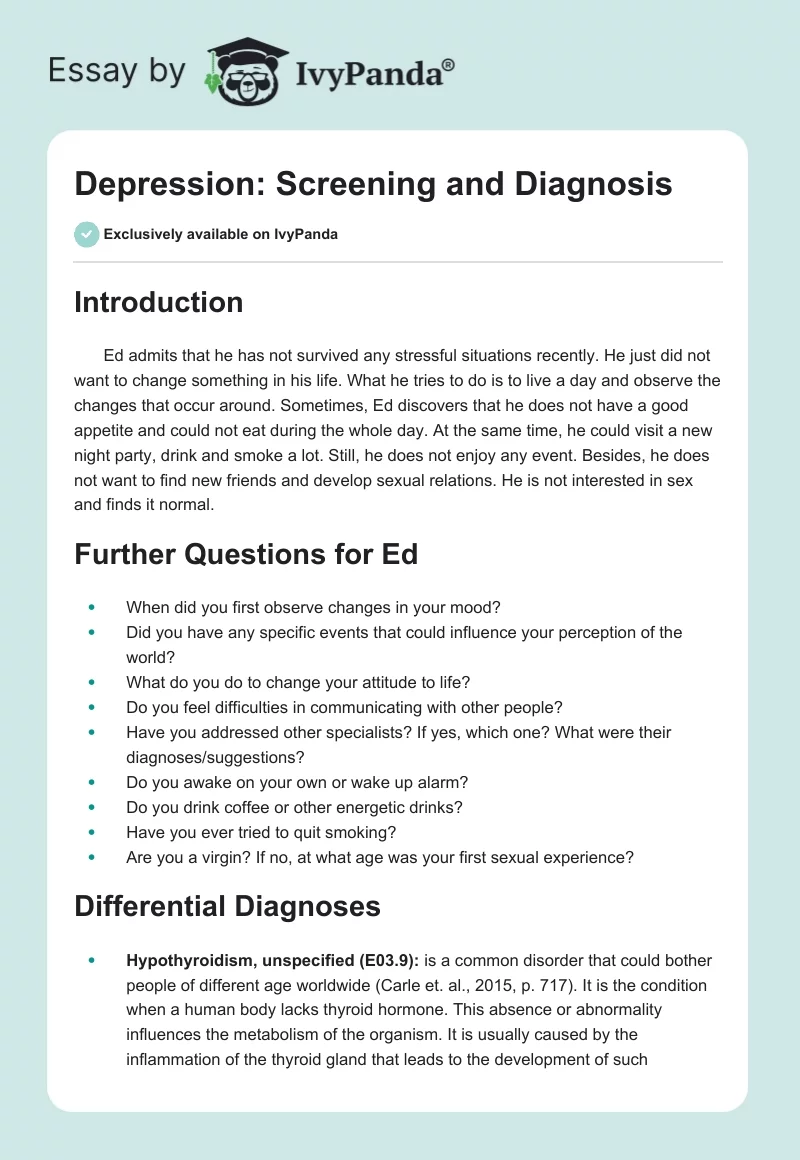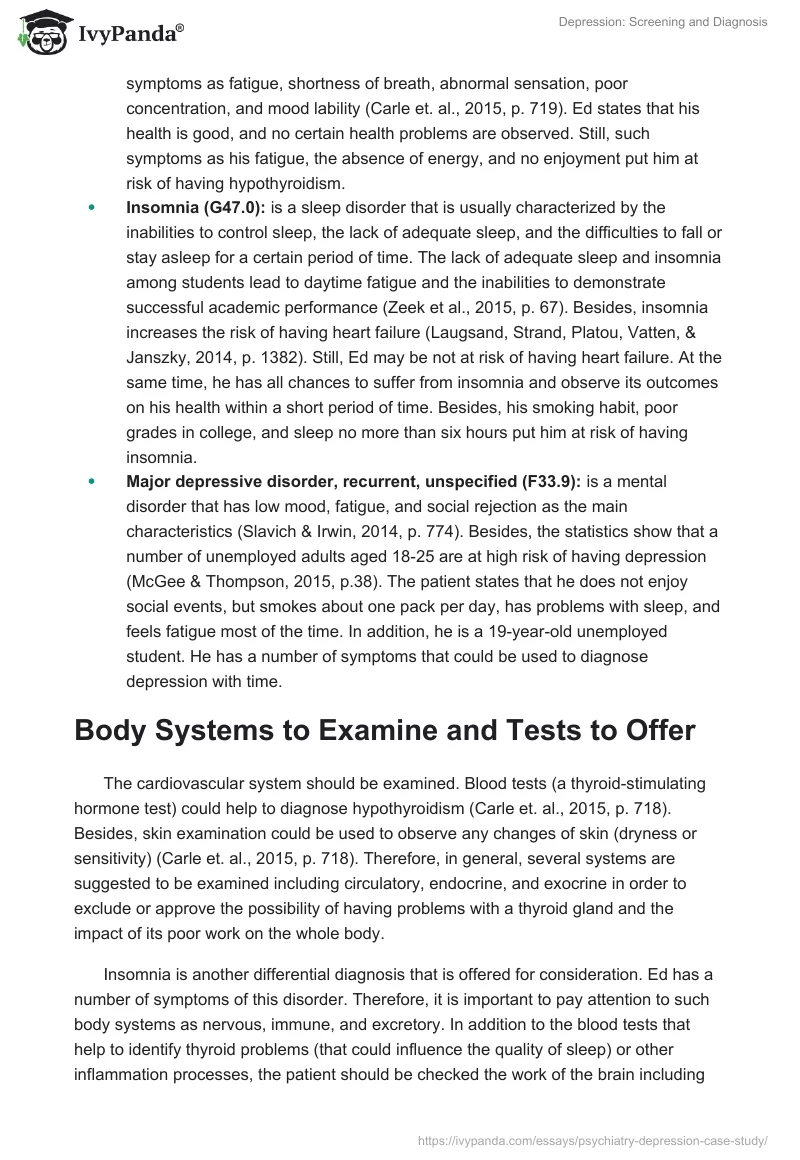Introduction
Ed admits that he has not survived any stressful situations recently. He just did not want to change something in his life. What he tries to do is to live a day and observe the changes that occur around. Sometimes, Ed discovers that he does not have a good appetite and could not eat during the whole day. At the same time, he could visit a new night party, drink and smoke a lot. Still, he does not enjoy any event. Besides, he does not want to find new friends and develop sexual relations. He is not interested in sex and finds it normal.
Further Questions for Ed
- When did you first observe changes in your mood?
- Did you have any specific events that could influence your perception of the world?
- What do you do to change your attitude to life?
- Do you feel difficulties in communicating with other people?
- Have you addressed other specialists? If yes, which one? What were their diagnoses/suggestions?
- Do you awake on your own or wake up alarm?
- Do you drink coffee or other energetic drinks?
- Have you ever tried to quit smoking?
- Are you a virgin? If no, at what age was your first sexual experience?
Differential Diagnoses
- Hypothyroidism, unspecified (E03.9): is a common disorder that could bother people of different age worldwide (Carle et. al., 2015, p. 717). It is the condition when a human body lacks thyroid hormone. This absence or abnormality influences the metabolism of the organism. It is usually caused by the inflammation of the thyroid gland that leads to the development of such symptoms as fatigue, shortness of breath, abnormal sensation, poor concentration, and mood lability (Carle et. al., 2015, p. 719). Ed states that his health is good, and no certain health problems are observed. Still, such symptoms as his fatigue, the absence of energy, and no enjoyment put him at risk of having hypothyroidism.
- Insomnia (G47.0): is a sleep disorder that is usually characterized by the inabilities to control sleep, the lack of adequate sleep, and the difficulties to fall or stay asleep for a certain period of time. The lack of adequate sleep and insomnia among students lead to daytime fatigue and the inabilities to demonstrate successful academic performance (Zeek et al., 2015, p. 67). Besides, insomnia increases the risk of having heart failure (Laugsand, Strand, Platou, Vatten, & Janszky, 2014, p. 1382). Still, Ed may be not at risk of having heart failure. At the same time, he has all chances to suffer from insomnia and observe its outcomes on his health within a short period of time. Besides, his smoking habit, poor grades in college, and sleep no more than six hours put him at risk of having insomnia.
- Major depressive disorder, recurrent, unspecified (F33.9): is a mental disorder that has low mood, fatigue, and social rejection as the main characteristics (Slavich & Irwin, 2014, p. 774). Besides, the statistics show that a number of unemployed adults aged 18-25 are at high risk of having depression (McGee & Thompson, 2015, p.38). The patient states that he does not enjoy social events, but smokes about one pack per day, has problems with sleep, and feels fatigue most of the time. In addition, he is a 19-year-old unemployed student. He has a number of symptoms that could be used to diagnose depression with time.
Body Systems to Examine and Tests to Offer
The cardiovascular system should be examined. Blood tests (a thyroid-stimulating hormone test) could help to diagnose hypothyroidism (Carle et. al., 2015, p. 718). Besides, skin examination could be used to observe any changes of skin (dryness or sensitivity) (Carle et. al., 2015, p. 718). Therefore, in general, several systems are suggested to be examined including circulatory, endocrine, and exocrine in order to exclude or approve the possibility of having problems with a thyroid gland and the impact of its poor work on the whole body.
Insomnia is another differential diagnosis that is offered for consideration. Ed has a number of symptoms of this disorder. Therefore, it is important to pay attention to such body systems as nervous, immune, and excretory. In addition to the blood tests that help to identify thyroid problems (that could influence the quality of sleep) or other inflammation processes, the patient should be checked the work of the brain including memory, reasoning, logic, and language (Zeek et al., 2015). Zeek et al. (2015) also offer to make use of questionnaires that could help to gather enough information about the quality of sleep, the reasons for why the patient could sleep well, and the events that could influence his sleep. Besides, it is offered to use observations in order to clarify the periods of the day/night, when the patient likes to sleep the most.
Depression may not require any additional tests expect some self-tests or special social stress tests (Slavich & Irwin, 2014, p. 785) that could demonstrate the level of personal problems and discontents with the environment. In general, such approach is possible in case the patient does not have psychological or mental disorders that could make his depression dangerous to the people around. The patient may be offered to use mobile health decision support systems (Bakken et al., 2014, p. 774) in order to gain control over his health and avoid the activities that could worsen his condition.
References
Bakken, S., Jia, H., Chen, E. S., Choi, J., John, R. M., Lee, N. J.,… & Currie, L. M. (2014). The effect of a mobile health decision support system on diagnosis and management of obesity, tobacco use, and depression in adults and children. The Journal for Nurse Practitioners, 10(10), 774-780.
Carlé, A., Pedersen,B. I., Knudsen, N., Perrild, H., Ovesen, L., & Laurberg, P. (2015). Gender differences in symptoms of hypothyroidism: A population‐based DanThyr study. Clinical Endocrinology, 83(5), 717-725.
Laugsand, L. E., Strand, L. B., Platou, C., Vatten, L. J., & Janszky, I. (2013). Insomnia and the risk of incident heart failure: a population study. European Heart Journal, 35(21), 1382-1393.
McGee, R. E. & Thompson, N. J. (2015). Peer reviewed: Unemployment and depression among emerging adults in 12 states, behavioral risk factor surveillance system, 2010. Preventing Chronic Disease, 12(3), 38.
Slavich, G. M. & Irwin, M. R. (2014). From stress to inflammation and major depressive disorder: A social signal transduction theory of depression. Psychological Bulletin, 140(3), 774-815.
Zeek, M. L., Savoie, M. J., Song, M., Kennemur, L. M., Qian, J., Jungnickel, P. W., & Westrick, S. C. (2015). Sleep duration and academic performance among student pharmacists. American Journal of Pharmaceutical Education, 79(5), 63-68.


